ISSN ONLINE(2278-8875) PRINT (2320-3765)
ISSN ONLINE(2278-8875) PRINT (2320-3765)
Roopa.V.G1, Arul Priya.K2
|
| Related article at Pubmed, Scholar Google |
Visit for more related articles at International Journal of Advanced Research in Electrical, Electronics and Instrumentation Engineering
People tracking are highly used in the surveillance applications. In this paper we introduced a system to track live video for tracking the person to find the intruder and make the surveillance area more secure. Human can perceive the objects and indentify the useful information and process sufficient information. Same way the video camera can identify the intruder. Here the pixel based approach is taken for the object detection. Background subtraction method is used for the moving object detection. Different aspects are taken for the input video and comparing the results for the processing video and time complexity. Mailing system is introduced here for the intruder alert with the internet connection in the server.
Keywords |
| Absolute difference, mask matrix, visual saliency, Binary |
INTRODUCTION |
| Visual tracking of people is important nowadays as the number of people coming in and out can be detected using computer vision. The problem of the visual tracking is consisting of several challenges like reliability requirement, number of cameras used and the position of the cameras. In this the live video is taken for processing so that we can get the result within no time. Here we used the pixel based approach rather than the region based approach. The technological innovations in the building will enable to the changing conditions and continuously respond which will increase the security of its occupants, efficient use of resources and fulfils the objectives of the owners. Researchers are working for the closing the gap between computer and human vision. The problem of the visual tracking is consisting of several challenges like reliability requirement, number of cameras used and the position of the cameras. |
| As reported [1] the tracking of people motion needs more than one camera for calibration which will distinguish human and object. In which the object height is taken is making the less efficient. Other systems based on optical barriers produced high error rate in terms of false negatives and false positives. The placement of the camera is another one of the challenge in the vision application. The overhead placement of more than one camera avoided the problems like occlusions, but the extracting the detailed information is not possible. As discussed in visual salience [3] the processing of video frames used the foreground object extraction will lead to background subtraction. Visual saliency method cannot apply directly to the real world objects. Object detection is done by pixel variation of the image from one frame to another and the background subtracted by the training process in the recorded videos. |
| In this paper the detection and tracking involves the extraction of feature point from video and continuous tracking of object trajectories of live videos. Proposed a visual tracking for the purpose of security in the banks, jewellery shop, military purpose, etc .Mounting video camera is cheap, but the observing the intruder for 24 hour time in the real time without any time delay is essential in the case of security purpose. In order to reduce the time complexity of processing of this frame is taken into consideration. Processing time for different cases is calculated and is compared in the last section. The mailing system is used here the instantaneous message to be send to the server about the intruder in the camera vision.Fig.1 shows the architecture of proposed system. |
RELATED WORK |
| More systems are introduced now for the tracking and counting the people motion in which the main problem faced was the position and orientation of the video camera. Here in [1] the height of the object or people is taken for distinguish between people and object. The rate of the motion, floor colour and the number of people will depend on the efficiency of the system. In the paper [2] used sub pixel measurement for providing the high accuracy in the stereo matching. In the paper [3] the video extraction frame work through motion and visual saliency is utilized, so that several visual and motion saliency are used for the foreground and background models in pixel based systems, but it takes more time for computation. The paper [5] describes the stored video processing in which the after background estimation the dilation, erosion and opening methods are used for the tracking of the people motion. In the proposed method the pixel based approach for identifying the moving pixel from the frame so that the every minute change can be identified. |
PROPOSED SYSTEM |
| For the visual security, the camera has to place in the required place. In this paper the placement of the camera is not important. Most of the surveillance system collect videos and store and process it afterwards. In this paper in order to maintain real time security, the real time videos are used for processing. Here by using background subtraction of frames moving pixel is extracted for identifying the intruder in the current frame. When the intruder is detected it is informed at the right time through the mail. As reported in [5] we are interested in both visual and motion saliency of the video frames, and the special features of the frames like Visual saliency, shape, and foreground/background color models etc. |
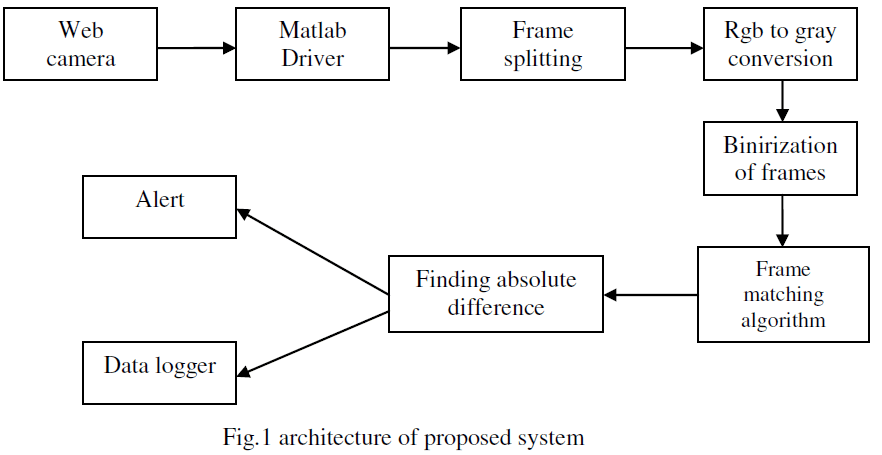 |
| By conditional random fields the integration features of foreground objects will identify the difference in the current frame. As in [6] visual tracking is done by pixel by pixel difference, we are using the absolute difference of the mask of the two consecutive frames. The time required for processing the live video are very high for the existing system, so the required output will not get, So here trying eliminate the latency in the processing of the frames by using the absolute difference of the mask of the matrix. |
SYSTEM ARCHITECTURE FOR TRACKING |
| Under the particular lighting of the area the camera has been placed in the proper place. The video is captured while the same time it is processed using visual tracking technology so that the change in previous frame with the current frame can be detected. The first step for this method is to split the frames to single frames. Then find the feature point of the resultant frame which is the mask of the frame or it is called as mask matrix. According to [7] the pixel by pixel variation is created using the absolute difference of the two adjacent frames. The result of this operation is the difference the previous and current frame. The difference image detects the motion of the current video. If it is a full black image then there is no moving object in the live video. Even if there is no motion in the current frame then also frame differencing will not be empty because of the quality of the camera and the by automatic processing. But the difference will not be so big. Hence we are giving some threshold value to decide the existence of motion in the current frame. If the motion is prevailed then a alert sound will be produced and by using the internet connection the alert mail is send the concerned person so that they can take appropriate action can be taken by the owners if any unknown person is came. In order to reduce time complexity of the processing of live videos rgb videos that are captured are converted to gray scale and then gray scale video is converted to binary valued frame. So that the pixel based approach for the motion of the pixel can be identified through binary frame. The different aspects of the intruder alert are taken into consideration. |
FRAME DIFFERENCING |
| In frame differencing of the system, the system will the current frame and it will analyses with the previous frame so that the finding out the pixel by pixel absolute difference of the matrix of these two frames. So if there is any difference between these two frames then alert will be generated by sound as well as through mailing with snap shot of the intruder frame to the concerned persons, so that they can take the appropriate actions. In the frame differencing we are not giving any threshold for the alert, it is automatic thresholding according to the background lighting. If there is no motion or change in the current frame than previous frame then the resulting difference of the frame will be blank. Otherwise if there is any motion then we are getting the differenced image. The figures below will show the frame differencing algorithm. |
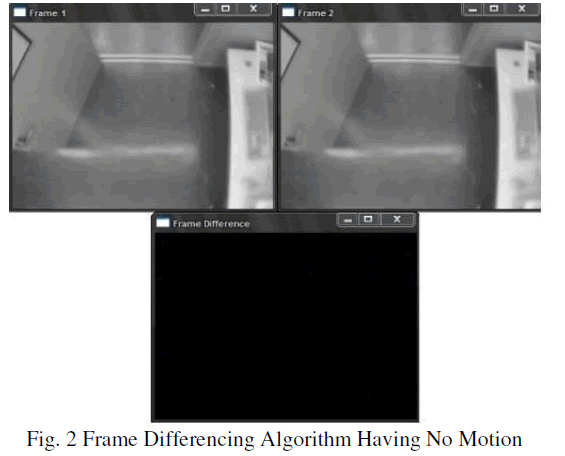 |
| In fig. 2 the two frames, Frame 1 and frame 2 are taken and find the absolute difference between the two corresponding frames are calculated. In this there is no difference between the frames so the frame difference is showing a black screen with no content. That means no motion or difference is finding out between the two frames. |
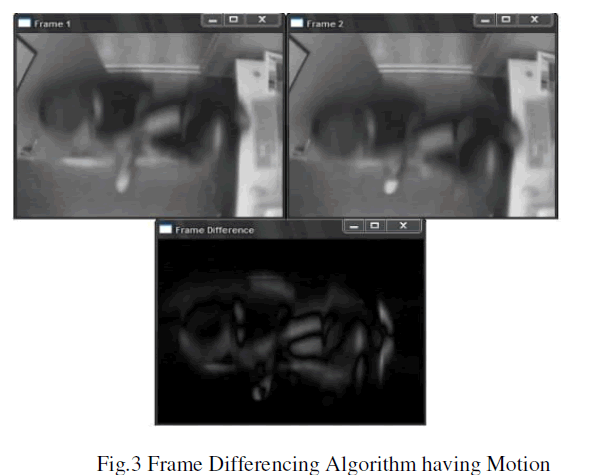 |
| In fig.3 also showing the difference between the two frames but there is some motion in the second frame compared to the first frame, Hence there showing something in the difference frame, that is finding the difference of the frame 2 with respect to frame 1 is calculated, and result will be the difference of the two frames. |
BACKGROUND SUBTRACTION |
| For getting the background subtracted frames with motion then we are using the adaptive background estimation method so that the system determines whether moving objects exist in a current frame by comparing the current frame with the previous frame. If there is no moving object, a new background image is obtained by averaging three frames including the previous background frame, the current background frame, and the current captured image. This background estimation method deals well with the gradual change of lighting, but cannot deal with the abrupt large change of lighting occurred in the whole image. To overcome this problem, we compensate the average intensity level of the illumination. From the background image and the current captured image, the average intensity levels of the four blocks each of which is located at the corner of the images are measured. The intensity difference between the corresponding intensity levels of two images is calculated and applied to the current background image to compensate the abrupt change of intensity if moving objects exist in the current image. |
MAILING SYSTEM |
| The mailing system that here used is a robust one only internet connection is needed for the mailing alert. Here user id and password of the concerned email is given, then without opening the mail the intruder alert with the alerting frame snap shot will be send to the concerned persons email id, within no time, so that the persons can take immediate action for the security. Here the time needed for estimating the intruder and sending the mail will be less. This system will update the frame snap shot for detecting the intruder who has passed the camera, Only the sending time by the network is needed to get the alert by mail. |
RESULTS AND DISCUSSIONS |
| The proposed system is tested with real time video from the properly fixed camera. The video is taken and here the time complexity to processing the frames needs to reduce for that the colour image acquired by the video camera is processing directly. So here the colour image acquired is converted into binary image so that processing time is reduced than it is converted into the gray scale image. First of all the colour image is displaying after that the binary difference of the image is calculated and the absolute difference with the previous frame and the current frame is calculated using the mask matrix. If there is any difference then intruder alert with frame is sending with a beep sound to the concerned person, so that they can take appropriate action for the security. |
| Table shows the times required by the system for intruder alert in different aspects, and compare the results. When we are comparing the time, the minimum time needed is for the rgb binary conversion. By comparing with the real time stored video time complexity for visual and motion saliency with [3] the time has been reduced. |
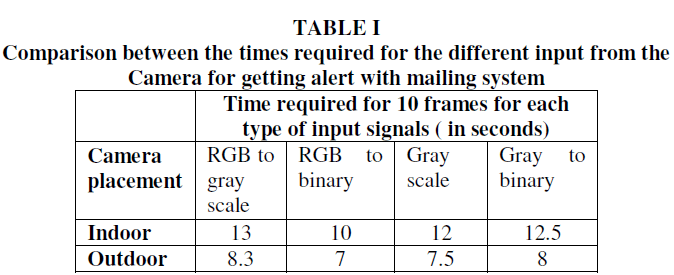 |
| Here table I shows the time required by the system when mailing system is used for the alert. The Input is converted from rgb to binary is taking less time for the alert than any other type of input conversions. Table II which is for the time required by the system when only the alert sound and logger can be included, by comparing to table I it is taking only less time when no mailing system is used. |
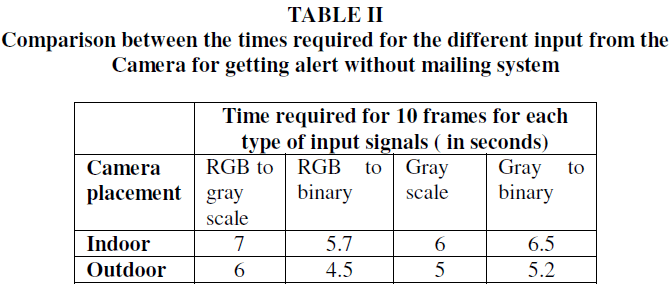 |
| From this table it is clear that colour image to binary converted image will take the less time for the processing. When compared to previous work this is very less time for the processing of the real time videos. Within the specified time the system will identify the intruder and will give the information to the concerned person by mail and will produce the alerting sound. By comparing with the real time stored video time complexity for visual and motion saliency with [3] the time has been reduced. The advantage of the system is that the cost for this system is reduced and there is no use of the sensors. The power consumption is also less based on the clarity and range of the live video that monitored by the camera. There is no need of the high clarity camera it will work on any type of camera. The main applications of this system are military applications, jeweller shop security, banking security, Automatic power saving system etc. |
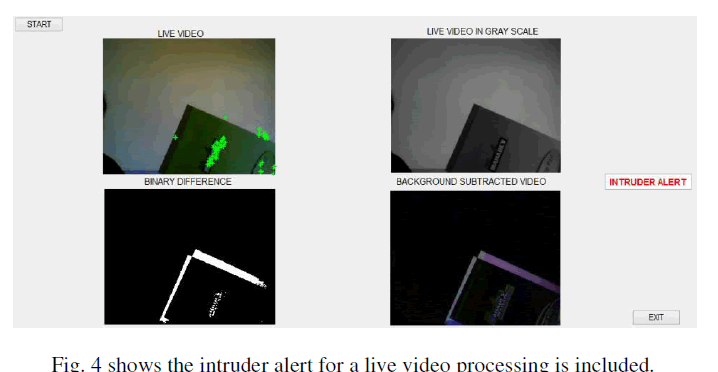 |
| Live video captured with intruder alert for the gray scale and binary difference frame, and also showing the background subtracted video for identifying the foreground object. The pixel variation from the previous frame to the current frame has been marked with green stars. For each frame having the pixel variation will be giving the intruder alert as well as sending the mailing alert and sending the frames with alert. |
CONCLUSION AND FUTURE WORK |
| In this paper introduced a proposal that to track the people using the camera and give the intruder alert if there is any change in the pixel on the live video. So that the colour image to binary image processing is used in order to reduce the time complexity of the system. Here the time required for processing is 7 seconds for 10 frames. So the frame rate has been reduced in the proposed system. Here the placement of camera and the resolution of the camera s not a matter for getting good result. It is only depend upon the processing of the video and the only needed is the internet connection for the working and on time information of the intruder alert. Individual tracking and multiple tracking can be introduced for the live videos and the system will be more useful and robust. |
References |
|